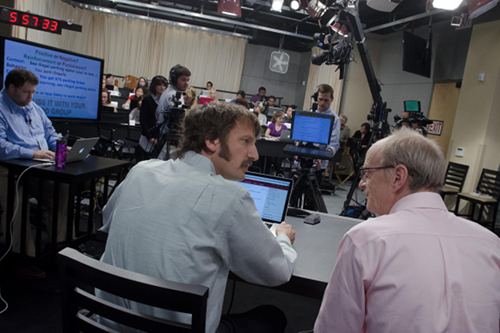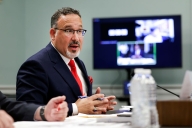You have /5 articles left.
Sign up for a free account or log in.
In 2012, we started teaching our Introductory Psychology course as a live online course. It was like a MOOC but was broadcast to 1,000 students who saw it in real time.
One challenge of building a SMOC (a synchronous massive online class) was how to define the nature of the relationship we would have with students. The choice was to teach the class as a regular stand-up lecture or to try something more akin to a TV show.
Sam Gosling (left) and James W. Pennebaker (right) on set. Photo courtesy of the authors.
At first, the differences between these two approaches seemed inconsequential. We had taught Introductory Psychology together for several years as a traditional lecture course for about 500 students. Both of us lectured on stage together in a large amphitheater, going back and forth between us.
When we started teaching online, we lectured to a studio audience of 20-25 students in a studio with three cameras, lights, and technicians jumping around. This was not the way any of us had ever experienced a classroom before.
Once the televised version of the class began, we experimented a bit with both the filmed-class and the TV-show formats. One key difference between the approaches was where we looked when we were lecturing.
Initially, we lectured to the members of the studio audience, connecting with the people in the room. However, doing this had the effect of making the students watching at home feel like observers of someone else’s class, not as participants in their own course. We gradually shifted to more of a TV-show approach where we looked directly into the camera.
It took some getting used to but after a few classes it became quite natural. Instead of standing and lecturing, we sat behind a desk like a late night talk show. Doing this did not have the effect of isolating the studio audience because they were close to the action.
Looking into the camera had the effect of making the online students feel connected to the class. Psychologically, we were with them in their dorm rooms or next to them in the library or café. Students told us that the TV-show format was more personal and intimate than being in a large classroom. Our analyses of the teaching evaluations confirmed this sense.
Realizing that our TV format was a medium that all the students understood led us to change the class in other ways. Instead of the standard hour-long lecture, we broke the class into segments. At the beginning of each class, we hosted a “Psychology in the News” segment (where we stood in front of a green screen image and related the day’s topic to some topical news story).
We frequently included “In the Expert’s Chair” where we would have a 6-minute interview with a world expert who would discuss a class topic from the researcher’s perspective.
One of our favorites was the segment called, “What’s Cooking in the Lab?” where we donned lab coats and conducted experiments that exposed a phenomenon relevant to the course. The segments were often humorous but, at the same time, intellectually challenging.
One of the great fears we all had when we started our online class was that it would be perceived as cold, distant, or anonymous. Some of our colleagues warned us that online learning could never replace the classroom experience.
They were partially correct.
The online class is not replacing the classroom experience. It is a new paradigm altogether. It has the potential to redefine the student-teacher relationship.
More than anything, it is forcing us to rethink how teaching works as we transition into the online world.
James W. Pennebaker is professor of psychology and chair and Sam Gosling is professor of psychology, both in the Department of Psychology at University of Texas, Austin.








